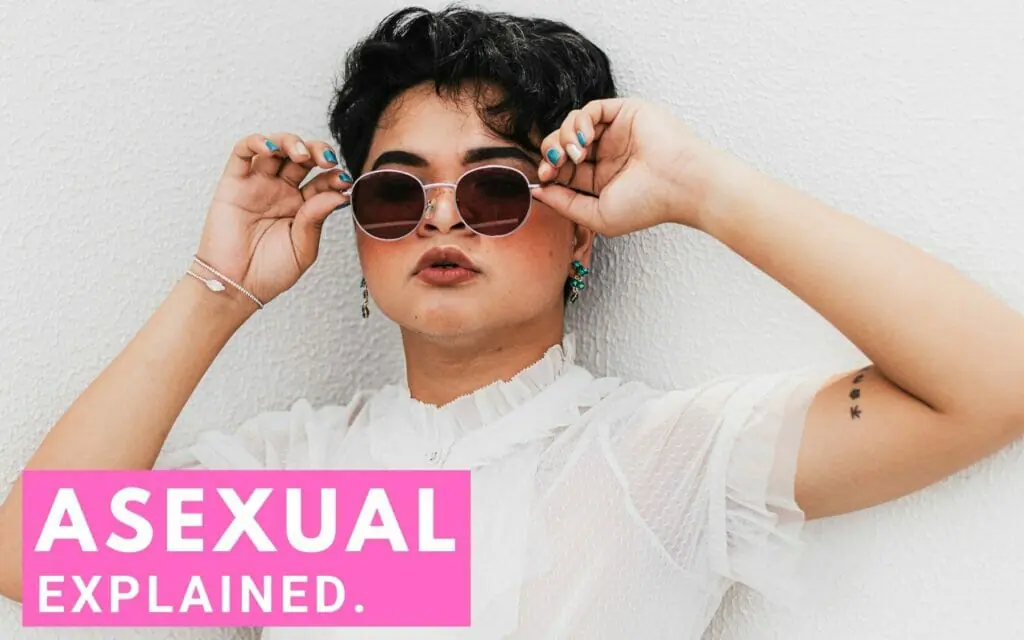The past several decades have seen a cultural awakening in regards to sexuality and representation – but when it comes to the best asexual movies…. it is fair to say that awakening is still yet to come. While it’s good to see sexual orientations that were considered taboo before are now celebrated, this hasn’t yet affected the way media portrays or doesn’t portray, asexuality – thus the limited pool from which to choose asexual films from.
Sex is almost everywhere in media. It’s very rare to see characters in movies where sexuality isn’t one of their main drives. As a result, people tend to think about sex as something that is necessary in order to live a full life.
Although this may be true for some, it’s a great disservice to asexual individuals, who live completely happy and fulfilling lives without the need for sex: the weight of this stigma really can’t be understated. Since it’s in the media where lots of our ideas about the lives of others come from, it’s important that every way of life is represented in what we watch. The fact that asexuality is so underrepresented works towards perpetuating these misconceptions about sexuality.
While there have been some examples of great asexual representation in TV and streaming series (like Sex Education and BoJack Horseman), the cinematic panorama is still missing these kinds of examples. There have been very influential asexual characters in movies, though. Some of them have been confirmed to be asexual by the creators and some are having been deemed asexual by the fans: in ace communities, much of their fight takes place in appropriating apparently asexual characters and seeing themselves in them, even when the creators are not in favor of the idea.
This list of best asexual movies features some of the best asexual characters, both confirmed and speculated, and the best asexual relationships that can be found in movies today
Wondering where to watch? It depends on where you live in the world and which streaming services you have. We link to the streaming service we watch on in each case - be it Netflix, Amazon Prime, Apply TV+, or elsewhere.
You can get one month free of Amazon Pride (or a 6-month trial for students) of Amazon Prime and also get immediate access to FREE Two Day shipping, Amazon Video, and Music. While you won't be charged for your free trial, you'll be upgraded to a paid membership plan automatically at the end of the trial period - though if you have already binged all these, you could just cancel before the trial ends.
Apple TV+ also has a one-week trial, and Hulu has a one-month trial (which can be bundled with Disney!). Another option might be using a VPN to access Netflix titles locked to other regions. Netflix is now available in more than 190 countries worldwide and each country has a different library and availability. US Netflix is (understandably) one of the best.
While we wish everything could just be in one place - for now, it seems these are the best streaming platforms to watch on.
In this article we will cover...
Star Trek II: The Wrath of Khan (1982)
The case of Spock is a great example of a character that is considered asexual by fans, but it’s not confirmed to be a part of the community.
Ever since the first installments of the foundational sci-fi TV show, people from all over the world have been drawn to the lack of passion that Vulcan’s display. Since the whole life of Spock’s race is ruled by logic, they have a very particular way of approaching love and sex (they only have sex once every seven years in order to prevent the race from extinction). Considering this, it’s no surprise that the character of Spock resonated so much with the asexual community.
Star Trek II: The Wrath of Khan, directed by Nicholas Meyer, is the second film of the famous sci-fi saga created by Gene Roddenberry. This is the film known for bringing Spock to the center stage and features some of his best moments ever in Star Trek. Following an episode of the first season, the movie sees the return of the mighty villain Khan Noonian Singh (played by the great Mexican actor Ricardo Montalban), a criminal who rose to power during the mythical Eugenics Wars.
The crew of the Enterprise, including William Shatner as Kirk and Leonard Nemoy as Spock, will face him in a battle some of them might not survive.
Straight Up (2019)
Straight Up is a romantic comedy created by James Sweeney, who wrote, directed, produced, and acted in the film. It tells the story of Todd, portrayed by Sweeny, a young over-thinker suffering from obsessive-compulsive disorder.
Everyone around Todd thinks he’s gay, he himself thinks he’s gay, but even the few encounters he had with other men left him feeling unsatisfied and unsure about sex. Perplexed about his own situation, Todd decides to give women a chance and starts looking for someone to go out with. This is how he meets Rory (Katie Findlay), a would-be actress who has lots in common with Todd. Particularly, the fact that the both of them are very lonely
The two of them start to stablish a relationship, and it feels good, but some things aren’t going as they “should”. The problem is that Todd and Rory like to be a couple, but don’t feel sexual attraction toward each other. They are more comfortable being just partners. Yet the people close to them insist that they should have sex. Straight Up will see the two of them try to deal with societal pressure and be true to their own selves.
Withnail & I (1987)
Withnail and I was written and directed by Bruce Robinson, known both for his movies and his roles as an actor. This black comedy was actually based on Robinson’s peculiar years while he lived in London during the sixties: it follows two struggling actors who have a very unusual relationship. First, there’s Withnail, played by a then-unknown Richard E. Grant, an alcoholic with lots of charm. Then there’s the titular “I”, played by Paul McGann, who is the complete opposite of Withnail. Set in 1969, the film sees the two of them in need of a holiday, so they accept Withnail’s Uncle invitation to spend a weekend with him in his luxurious farmhouses. Yet they will find Uncle Morty very, very, hard to live with.
What’s interesting about the film, besides the hilarious writing and great performances by its main characters is the relationship between Withnail and “I”. The two of them share an apartment in the neighborhood of Camden. In fact, they even share a bed. This draws the attention of both their neighbors and their friends, who seem perplexed by their relationship and think that they are gay but feel uncomfortable coming out of the closet.
Yet this is never revealed to be the case. The film shows them as two mature and intelligent individuals who just don’t care for sex or sexual desire. It is no coincidence that the film ends with one of Hamlet’s most interesting phrases: “Man delights not me. No. Nor women neither”.
Time Without Pulse [Tiempo sin pulso] (2016)
Time Without Pulse is the first film by Mexican director Bárbara Ochoa Castañeda. It’s a touching drama set in Mexico City that chronicles the life of a family after they lose one of their loved ones. Although we get to see the points of view of everyone in the family, the film focuses on Bruno, a teenager who is having a really hard time dealing with grief.
While his mother has turned to medication and his father has distanced himself from the family, Bruno has taken perhaps the worst route: he has decided that his way to deal with the pain would be to stay away from anything that makes him happy.
The film sees Bruno facing off against depression and trying to find a place for himself in the world. His life seems to turn for the better when his ex-girlfriend, Elisa, returns to the city and meets with him again. Yet in this reunion Bruno will discover something new about himself, a new challenge that he’ll have to face, perhaps not alone. Time Without Pulse is a moving drama and one of the few South American movies that deal with asexuality.
Although there have been some in the community that have criticized the portrayal of ace teenagers in the film, the lack of asexual representation makes it one of the most important asexual movies to watch nonetheless.
Finding Neverland (2004)
Finding Neverland, by Marc Foster, tells the story of Scottish writer James Mathew Barrie. While in this day and age his name may be less recognizable, Barrie has had an incredible influence in many of our lives: he was the creator of children’s literature classic “Peter Pan”.
The story of the boy who didn’t want to grow old connected with lots of people, both young and adults. What’s most intriguing is that Barrie had a similar outlook on life as Peter: he was disappointed by adult life and carried himself with the kind of innocence a young man would have. There are many labels that people have ascribed to Barrie, but today he’s recognized by many as an asexual man who, despite being married, didn’t care for sex at all.
The film begins when Barrie (played by Johnny Depp) watches as his latest work captivates the refined Edwardian society of 19th century England. While Barrie is a very talented when it comes to writing, he has become disenchanted with the things he writes about. One day, while taking his dog for a walk through the beautiful Kensington Gardens, he meets a peculiar family: a recent widow (Kate Winselt) and her four children. When Barrie decides to adopt them, his life changes forever.
Lost In Translation (2003)
While many people don’t consider it an asexual movie, the story of Lost in Translation sees two people slowly fall in love without ever having sex as a part of their relationship.
When Bob Harris (Bill Murray) meets another American in a hotel in Tokyo, particularly one as young and beautiful as Charlotte (Scarlett Johansson), the last thing he’s looking for is sex. What he wants is company, someone to be there with him, someone who can understand him. They come from different lives, Bob is a movie star who has come to shoot a whiskey commercial and Charlotte has come to accompany her workaholic husband, but they quickly find they have much in common. For once, they both have insomnia. They one night at the hotel’s bar, and from there something quite beautiful emerges.
Lost in Translation, by Sofia Coppola, manages to capture a truly touching relationship that has nothing to do with sex. One could argue that, despite the two main characters being alosexual (meaning that they are interested in sex and experience sexual desire), the romance in the film is completely asexual and thus we consider it one of the best asexual movies. This is much more interesting if one considers that the film won numerous awards, including an Academy Award for Best Writing.
Sherlock Holmes (2009)
Directed by the great Guy Ritchie (the mind behind Snatch), Sherlock Holmes sees the return of the famed detective to the big screen. This time, the one to bring the character to life is Robert Downey Jr., who had just revitalized his career with the successful Iron Man after a long time dealing with his alcoholism (perhaps one of the many traits that made him perfect for the role).
Set in London during the 1890s, the film sees Holmes and his loyal partner Dr. Watson (Jude Law) going after a gruesome killer by the name of Henry Blackwood (Mark Strong). Although it seems like they managed to catch him, Holmes has his doubts and, three months later, a new chase ensues.
Sherlock Holmes is perhaps one of the most famous asexual characters in media. While the BBC adaptation leans more on his relationship with Moriarty, the films do not portray this as an attraction between two enemies. They are, rather, just enemies. Some fans of the books think that his relationship with Irene Adler, the only woman to ever best him, can be seen as a romantic desire.
However, the asexual community has taken Holmes as one of their own, since they feel strongly represented in his search for an intellectual match to his own intelligence, rather than a sexual or romantic partner.
Year Of The Dog (2007)
Year of the Dog, by Mike White, is a touching film about love and what happens to us when we lose those we love.
The film follows Peggy (Molly Shannon), an awkward and lonely single woman whose only company is her dear pet beagle, who she has named Pencil. After a tragic accident, Pencil dies and Peggy’s life is thrown into disarray. Nor her family nor her friends seem to be able to help her. Suddenly, Peggy seems to find her way in life: she gets involved in animal rights activism. The catch is that being such an emotional wreck, Peggy gets involved a little too much, causing much chaos on her way.
The film features a prevalent asexual character, Newt (played by Peter Skarsgaard). He’s an animal lover who works at an animal refuge and offers Peggy a new dog to adopt. It’s through Newt that Peggy finds herself learning about veganism and animal rights activism, joining the same fight as him. Yet she doesn’t see him as just a peer: Peggy is sure that Newt is just as in love with her as she is with him. Year of the Dog sees Peggy trying to deal with the asexual nature of his friend while she works at getting better.
The Watchmen (2009)
The Watchmen, directed by Zack Snyder, revolutionized the superhero genre with its portrayal of deeply flawed heroes who were hated by the society they had sworn to protect. Set in an alternative reality eighties, the film sees the long-retired superhero team of the Watchmen reuniting.
One of their old members, the Comedian, was murdered, and the psychotic detective Rorschach is on the case. As someone who never got over the end of the superhero era, Rorschach reunites the other members of the team (Night Owl, Silk Specter, Dr. Manhattan, and Ozymandias) and little by little gets them involved in a conspiracy that’s much bigger than any of them (who is behind this conspiracy will be revealed in the next paragraph).
Perhaps the most important character in The Watchmen story is actually considered asexual, not only by fans but also by the actor himself. This character is Adrian Veidt, also known for his superhero name of Ozymandias, the billionaire and tech leader who is the sole mind behind the dark conspiracy that looms over the world of the film. He was interpreted by Matthew Goode, who has repeatedly said in interviews that he played the character as someone who was completely asexual, meaning that the pursuit of his goals is the only thing that interests him. So he’s pretty much confirmed to be asexual.
While not the main focus of the movie, Ozymandias is the man who orchestrated the conspiracy, and it’s great to see an asexual character who is also a villain, but it’s not considered evil for being queer.
The Olivia Experiment (2012)
The Olivia Experiment, by Sonja Schenk, is one of the best-known films dealing with asexuality. It tells the story of Olivia (Skye Noel), a university student pursuing gender studies who can’t seem to find her footing in life.
While she has much going for herself, she can’t get over the fact that, at 27 years old, she’s still a virgin. “Why?”, one may ask. Well, Olivia has never felt any attraction for men or women, so she never pursued those who were interested on her. She comes to the realization that she may be asexual and tries to become part of an asexual support group but finds that the people there are rude to her and leaves. The titular experiment comes when her friend offers to lend her boyfriend to Olivia so she can learn what sex is.
This is perhaps the most notorious asexual movie on the list, since it deals with the problem of asexuality head-on, although not in a good way: it portrays asexual people as unwelcoming and asexuality as something one needs to overcome. Yet the film goes a little bit beyond that, critiquing our sex-obsessed society (which is much more prevalent on university campuses) and presenting meaningful relationships as the thing that one needs to be happy. While it’s a good message, it could have done so without putting down asexuality.
Still, the film is one of the very few times an asexual group is portrayed in cinema.
(A)sexual (2011)
(A)sexual, by Angela Tucker, is a documentary that tells the story of many asexual individuals, the most relevant of them being David Jay. Most asexuals online are bound to know Jay, or at least know his work. An asexual individual himself, in 2001 he founded AVEN, the Asexuality Visibility and Education Network.
He has spent the last twenty years spreading knowledge about asexuality and is a figurehead for the community as a whole. The documentary dives deep into the subject of asexuality, not only showing the life of asexual individuals but also making an attempt to define this particular way of seeing the world. There have been some that criticized this attempt to pin down what being asexual is, but it’s also true that this documentary has gone to great lengths at making people aware of the subject.
While (A)sexual can be enjoyed by everyone, asexual viewers should be aware that the documentary shows lots of misconceptions about asexuality. Particularly, there are several clips where David Jay talks with the hostesses of The View, who interview him about asexuality in a very disrespectful manner. The documentary has more than ten years, so people were even less educated about asexuality back then. However, Jay does conduct himself very well and, even though he’s not treated in the best manner, manages to give elucidating answers to their silly questions.
The Hangover (2009)
Most moviegoers are familiar with the premise of The Hangover, by Todd Phillips: just two days before the date of his wedding, soon-to-be-married Doug (Justin Bartha) travels to Las Vegas in order to party one last time.
He goes there with his life-long friends, Phil (Bradley Cooper) and Stu (Ed Helms), and his future brother-in-law, Alan (Zach Galifianakis). They do manage to have a tremendous farewell, yet problems arise when they wake up the next day. They all suffer from terrible hangovers and can’t remember anything about what happened. That’s the easy part: they can’t find Doug anywhere. The Hangover will see these three trying to find the groom just in time for his wedding.
After watching the first two films in the franchise, fans where left wondering about Alan’s sexual orientation. He’s perhaps the most peculiar of the bunch: suffering from ADHD and a whole lot of social anxiety, many watchers saw themselves reflected on his way of being. Before the release of the third movie, the director answered the fan’s questions and told the world that Alan was asexual.
For some viewers, this was a surprise, but others had long seen it coming. While it’s not directly addressed in the film, the character of Alan is one of the few asexuals in high-grossing comedies.






